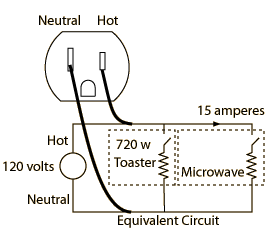 |
| Type B Plug |
Type A and Type B plugs are used for 120 volts. Type A has been phased out, but rarely seen. Type B plugs are in all new buildings and houses since the 1970's.
 |
| Type A Plug |
Two vs. three contacts
Each commonly-used power receptacle has two or three distinct wired contacts. The contacts may be steel or brass, and may be plated with zinc, tin, or nickel. Since alternating current (AC) is predominantly used in energy distribution networks, both live and neutral contacts typically carry current from the source to the load and from the load to the source, changing direction 60 times per second. However only the neutral contact remains at or very near the voltage potential of the earth, while the potential of the live contact changes sinusoidally, for example -125 V to +125 V (peak-to-peak). The Type B plug has two flat parallel blades like Type A, but also adds a round or U-shaped grounding prong (American standard NEMA 5-15/CSA 22.2, No.42).[11] It is rated for 15 amperes at 125 volts.
Polarization
Polarized plugs and sockets are those designed to connect only in one orientation, so the live and neutral conductors of the outlet are connected (respectively) to the live and neutral poles of the appliance. Polarization is maintained by the shape, size, or position of plug pins and socket holes to ensure that a plug fits only one way into a socket. The switch of the appliance is then connected in series with the live wire. If the neutral wire were interrupted instead, the device would be deactivated but its internal wiring would still remain live. This is a shock hazard; if the energized parts are touched, current travels to earth through the body. Devices that especially present this hazard include toasters and other appliances with exposed heating elements, which with reversed polarity can remain live even when they are cool to the touch.
Many receptacles and plugs also include a third contact for a connection to earth ground, intended to protect against insulation failure of the connected device. A common approach is for electrical sockets to have three holes, which can accommodate either 3-pin earthed or 2-pin non-earthed plugs.
The different sized slots were developed to allow outlets to be polarized as a safety enhancement. The larger slot connects the common wire in the outlet to the common wire in a device. The smaller slot connects the "hot" wires. By forcing the smaller blade of the plug to always connect the hot wires, the outlet is polarized. Devices, such as a table lamp, are designed to minimize the risk of electric shock by keeping the hot wire as short as possible by wiring directly to the switch. The rest of the internal wiring connects to the neutral wire. While this system does not eliminate the possibility of electrocution, fire and electrical faults, it reduces the risk by limiting the path of live current.
What does the ground do?
Another improvement in safety came with the addition of a ground wire to the outlet. This serves as an alternative return path for electricity and is referred to as the equipment ground. Ordinarily current flows from the hot wire and returns via the common wire to ground. However, if the hot wire comes in contact with a metal part of a device, the outer cabinet housing of a washing machine for instance, current could flow through you to ground. The ground wire in a device connects to the housing and provides a return path. The current could still travel through you, but the ground wire probably has lower resistance and so chooses that path over through you.
The standard U.S. household wiring design has two 120 volt "hot" wires and a neutral which is at ground potential. The two 120 volt wires are obtained by grounding the centertap of the transformer supplying the house so that when one hot wire is swinging positive with respect to ground, the other is swinging negative. This versatile design allows the use of either hot wire to supply the standard 120 volt household circuits. For higher power applications like clothes dryers, electric ranges, air conditioners, etc. , both hot wires can be used to produce a 240 volt circuit.
The high voltage (about 120 volts effective, 60 Hz AC) is supplied to the smaller prong of the standard polarized U.S. receptacle. It is commonly called the "hot wire". If an appliance is plugged into the receptacle, then electric current will flow through the appliance and then back to the wider prong, the neutral. The neutral wire carries the current back to the electrical panel and from there to the earth (ground). The ground wire is not a part of the electrical circuit, but is desirable for prevention of electric shock.
The two receptacles in a common "duplex" receptacle receive power from the same circuit leading from the main electrical supply panel. They are wired in parallel so that two appliances which are plugged into the receptacle receive the same voltage, but can draw different amounts of electric current. Parallel wiring is the standard for 120 volt circuits in the entire house, making possible the independent use of all appliances, supplied by the same voltage.
The wider prong on the polarized plug will permit it to be plugged in only with the correct polarity. The narrower prong is the "hot" lead and the switch to the appliance is placed in that lead, gauranteeing that no voltage will reach the appliance when it is switched off. A non-polarized plug may have the switch in the neutral leg and thus be a shock hazard even when it is switched off.
(Electrical Outlet.org, Wikipedia, ACME How To, Hyperphysics)




No comments:
Post a Comment